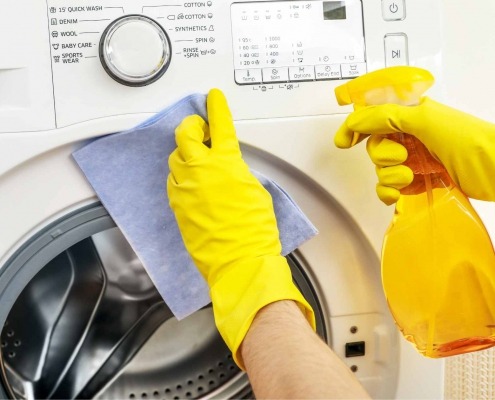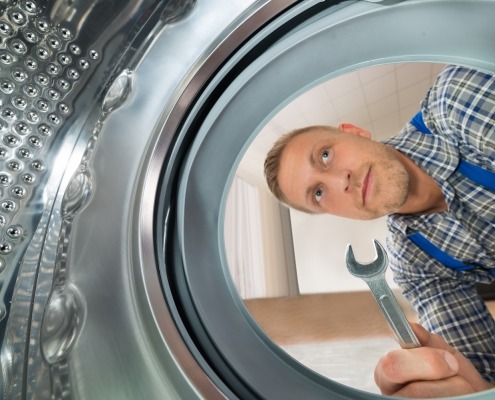How To Remove Hard Water Deposits From Your Washing Machine
Steven E / Wednesday April 30, 2025
If you’ve got hard water, you probably know it can be a real pain. Not only do mineral deposits look gross, but they can also affect how well your washer works and even make your clothes smell funky. The good news? Getting rid of those stubborn deposits is easier than you might think! With just a few simple tricks and stuff you probably already have at home, you can get your washer back in shape. Let’s jump in and tackle those hard water issues like a Pro!
If you need any replacement parts for your appliance, you can enter your model number at AppliancePartsPros.com to order them. Most orders arrive in just two business days, and we have thousands of free guides to show you how to install your new parts.
The information in this article may not apply to your specific appliance model. We recommend consulting your manufacturer’s documentation or contact us with any questions.
What are hard water deposits?
- Hard water deposits typically appear as a chalky, white, or off-white residue. You may notice these deposits on various parts of your washing machine, including the drum, detergent dispenser, and hoses.
- In areas with hard water, you might observe scale formations resembling tiny, hard crystals. These can accumulate on the heating element, in the drum, and around the water inlet valve.
- A decrease in water flow during the wash cycle can indicate that deposits have built up in the water inlet valve or hoses, restricting water intake.
- Hard water deposits can trap dirt and detergent residue, leading to unpleasant odors emanating from your washing machine.
- If your laundry isn’t coming out as clean as it used to, this could be a sign of hard water deposits interfering with the washing process.
- Deposits on the drum or other components can create noise and vibrations during the wash cycle as the machine struggles to function properly.
Step 1: Clean the detergent dispenser
The detergent dispenser in your washing machine can accumulate hard water deposits over time, affecting its functionality and cleanliness. Follow these steps to effectively clean the detergent dispenser:
- Most detergent dispensers can be easily removed by pulling them out or pressing a release button, depending on the model of your washing machine. Consult the user manual if you’re unsure about how to remove it.
- Fill a basin or sink with the solution, ensuring there is enough liquid to completely submerge the dispenser. The acidic properties of white vinegar help break down the mineral deposits.
- Allow the detergent dispenser to sit in the vinegar solution for at least 30 minutes. This will give the vinegar enough time to dissolve the hard water deposits and grime.
- After soaking, take a soft cloth or sponge and gently scrub the detergent dispenser. Pay close attention to the nooks and crannies where residue might be trapped. For stubborn deposits, you can use an old toothbrush to scrub away the buildup.
- Once you have thoroughly scrubbed the dispenser, rinse it under running water to remove any remaining vinegar solution and loosened deposits. Make sure to remove all traces of vinegar to prevent any unwanted odor in future washes.
- After rinsing, place the detergent dispenser on a clean towel or drying rack and allow it to air dry completely. It’s important to ensure that it is completely dry to prevent any moisture-related issues or mold growth.
- Once the dispenser is dry, carefully reattach it to the washing machine. Give it a gentle push or click to confirm proper attachment.
Step 2: Clean the water inlet valve and fill hoses
The water inlet valve and fill hoses of your washing machine supply water for each wash cycle. Over time, these components can become clogged with sediment, debris, or mineral deposits, leading to reduced water flow. Follow these steps to clean the water inlet valve and fill hoses:
- The water inlet valve is usually located at the back of the washing machine, where the fill hoses connect. The fill hoses are typically connected to the valve and extend to the water supply source.
- Using pliers or a wrench, carefully loosen the connections between the fill hoses and the water inlet valve. Place a towel or bucket beneath the hoses to catch any water that may spill out.
- Examine the hoses for any signs of damage, cracks, or bulges. Similarly, inspect the water inlet valve for visible debris, sediment, or mineral buildup.
- Use a soft brush or toothbrush to gently scrub the valve’s screen and openings. This will help remove any accumulated debris or deposits.
- Check for removable valve filters and clean or replace them if necessary. If the valve is not able to be cleaned or damaged you may need to replace the complete valve assembly.
- Inspect the inside of the fill hoses for any debris or buildup. If you notice significant deposits, it may be necessary to replace the hoses.
Step 3: Descale the drum and agitator
Over time, hard water deposits can accumulate inside the drum and agitator of your washing machine. Follow these steps to clean the drum and agitator:
Option 1: Using white vinegar and hot water
- Start by filling the washing machine drum with hot water until it is halfway full.
- Pour 2 cups of white vinegar into the water in the drum. The acidity of the vinegar helps dissolve the hard water deposits.
- Run the washing machine on a regular cycle for a few minutes to allow the vinegar solution to mix and distribute throughout the drum and agitator.
- Pause the washing machine cycle and let the vinegar solution sit in the drum for about an hour. This extended contact time will help break down the deposits.
- After the hour has passed, resume the cycle and let it complete. The hot water and vinegar will work together to dissolve and remove the hard water deposits.
- Once the cycle is finished, use a soft cloth or sponge to wipe the drum and agitator. This will help remove any loosened deposits and leave the surfaces clean.
Option 2: Using baking soda and hot water
- In a small bowl, mix 1/4 cup of baking soda with 1/4 cup of water to form a paste. Baking soda is known for its cleaning and deodorizing properties.
- Apply the baking soda paste to the drum and agitator, focusing on areas with visible hard water deposits. Use a soft cloth or sponge to spread the paste evenly.
- Allow the baking soda paste to sit on the surfaces for about 30 minutes. This will give it time to penetrate and break down the deposits.
- After the 30 minutes, use a toothbrush or soft brush to scrub the drum and agitator. Pay attention to areas with stubborn deposits and scrub gently to avoid damaging the surfaces.
- Rinse the drum and agitator thoroughly with hot water. Ensure that all the baking soda and loosened deposits are washed away.
Option 3: Using citric acid solution
- In a gallon of hot water, dissolve 1/4 cup of citric acid powder. Citric acid is effective in breaking down mineral deposits.
- Pour the citric acid solution into the washing machine drum and agitator, ensuring that the surfaces are covered.
- Allow the citric acid solution to sit in the drum and agitator for about an hour. This will give it time to dissolve the hard water deposits.
- Start a regular cycle on the hottest water setting to activate the citric acid solution. This will help remove the deposits effectively.
- After the cycle is complete, use a soft cloth or sponge to wipe the drum and agitator, removing any remaining residue or deposits.
Preventive measures to avoid future buildup
To prevent the buildup of hard water deposits in your washing machine, it’s important to implement preventive measures. Here are some steps you can take to avoid future buildup:
- Install a water softener system in your home to treat the hard water before it enters your washing machine. Water softeners remove minerals that cause hardness, such as calcium and magnesium, reducing the likelihood of deposits forming in your machine.
- Use the appropriate amount of detergent recommended for your specific washing machine and the load size. Excessive detergent can contribute to the buildup of residues and deposits.
- Periodically inspect and clean the water inlet screens or filters if your washing machine has them. These screens can become clogged with sediment and minerals, affecting water flow and increasing the risk of deposits forming in the machine.
Additional information
Thank you for reading! We hope this guide helped you get your washer clean again.
If you have any other appliance repair needs or projects, don’t hesitate to explore our other troubleshooting guides and videos.
If you need replacement parts or some extra help with ordering them, grab your model number and head over to AppliancePartsPros.com, where you can chat with a pro, read our DIY blog and more.
Be sure to subscribe to us on YouTube and follow us on Facebook, Twitter and Instagram!
With nearly a decade of experience in providing top-notch customer service regarding appliance parts and repair, Steven enjoys sharing practical advice, troubleshooting tips, and interesting information to help readers stay informed.





